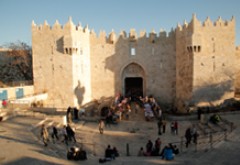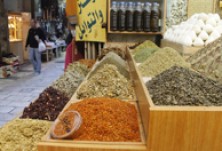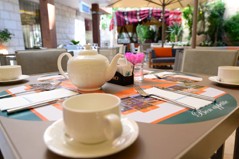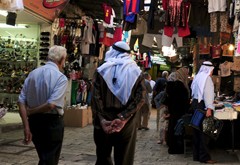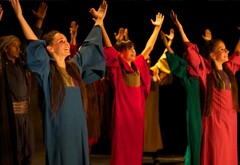The Arab Islamic siege of the city ended with surrendering the city keys to the Caliph Omar Ibn Al-Khattab, who guaranteed in a document he signed, the civilizational continuity and religious and social tolerance for the Christian residents of the city. That document, known as the "the Pledge of Omar," continued, for a long time, to regulate relations between Muslims and Christians in Jerusalem. The story of Omar Ibn Al-Khattab's visit is related in most Islamic and Christian sources, including what is mentioned as the Caliph refusing to pray inside the Church of the Holy Sepulcher during his visit, although the call for prayer was raised, preferring to pray in the church's courtyard, so that Muslims do not control the church with the excuse that Omar prayed in it.
Jerusalem was connected to Islam long before the Islamic campaign, being the first of the two Qiblahs (the direction Muslims face in prayer), and the track the Prophet Mohammad took as he ascended to Heaven. This connection increased with time, as Muslim relations and activities increased in the city. Jerusalem was also connected to a number of important historic Islamic notables, who added a new dimension to this relationship. The Islamic presence was accompanied by a great construction and development movement through an integrated project, which included the whole area of Al-Haram Al-Sharif, culminating with the building of the Dome of the Rock and Al-Aqsa Mosque, and their surrounding grounds, with all their gates, overpasses basements, and palaces, to form the jewel of the city, in addition to fortifying the city by completing the walls and restoring parts of the Citadel.
The Umayyad Jerusalem (660 - 750 AD), with the Dome of the Rock and Al-Aqsa Mosque has become an architectural and artistic school, comprising the most important Islamic structures in the whole world. With Islam, Jerusalem gained a new global dimension, after being restricted to the Christian dimension. In addition, it played an important role due to its holiness and close proximity to the center of the Caliphate. This role exceeded its prestigious religious status into a central political and administrative role, as witnessed by the size of the palaces (the Umayyad Emirate House to the southwest of Al-Aqsa Mosque praying niche).
There is sufficient evidence that Jerusalem was revived, socially and economically during the Umayyad period, with stability that it had not enjoyed for a long time. What added to this stability were numerous visits by caliphs and princes from the Umayyad house, who spent long periods of time, managing the Umayyad state affairs from Jerusalem, which influenced its growth and centrality.
Large numbers of other Arabs also settled in Jerusalem, and its Sanctuary became a destination for Muslims from throughout the Islamic world. It was also evident that Christian and Muslim pilgrimage increased noticeably during this period, enhanced by a seasonal market which was held on 12 September of each year.
With the Abbasid revolution against the Umayyads (750 AD), the center of th caliphate was moved from Damascus, the capital of Greater Syria and the Umayyad state, to Baghdad, and with it the center of influence and civilized activity. In spite of the exceptional care provided by the Abbasids for the holy places, they were unable to add anything outstanding in Jerusalem. The reason may not be the lack of interest, but because the need for public buildings, particularly religious ones, was completed by the Umayyads, especially in Al-Haram Al-Sharif area, and the Abbasids had only to preserve and maintain these buildings, particularly during the times of Al-Mansour (754 - 775), Al-Mahdi (775 - 785), and Al-Ma'moun (813 - 833), when the city suffered a series of devastating earthquakes during their rule. Indeed, the Abbasids had no special interest in restoring the symbols of the Umayyad rule (Emirate's House), which were devastated by earthquakes even before the Abbasids came to power. It is noted that a number of Abbasid caliphs visited the city, including Al-Mansour, after he performed Hajj in 758 AD, and returned once more in 771 AD. His son, Al-Majid, also arrived in Jerusalem specifically, in addition to many other caliphs.
The Abbasid period is divided into two, the first normally referred to as the golden era and continued for about a century, during which powerful caliphs ruled, and power was almost purely Arab. The second saw various sultans from BaniBoayh and Turkish Seljuqs, when regional independence movements prevailed. Interest in Jerusalem, however, was not affected, but nothing precipitated from this period indicating its characteristics, with the exception of some periodic restoration and maintenance work extending to all the components of Al-Haram Al-Sharif, where each structure was restored many times.
Egypt and Bilad Al-Sham were relatively independent from the Abbasid rule under the rule of Ahmad Bin Tolun, who established the Tolun state which ruled Jerusalem (878 - 905 AD), and which spent most of its time in military operations, commensurate with its nature, and did not leave any archaeological sites in the city, with the exception of some fortifications which disappeared as a result of the Crusader devastation.
Jerusalem was then ruled by the Ikhshidi state (939 - 969 AD), a short period after the direct Abbasid rule (normally referred to as the Walis' (governors) era, 905 - 939 AD). The Ikhshidis had a close relationship with Jerusalem, and were brought, after their death to be buried in its soil. During their rule as Walis of the city, Jerusalem was the target, like the rest of Palestine, of campaigns by Al-Qaramitah, which instigated the Seljuq sultans to interfere directly in the administrative affairs of Jerusalem. Yet this did not last for long, with the arrival of a young army from the Arab Maghreb, which invaded Egypt and then Palestine, bringing a different faith from the prevailing Sunni one, namely, the Ismaili Fatimid faith.
The Shia Fatimids conquered Jerusalem in 969 AD, overturning the city's Sunni faith, which had prevailed over two centuries. They presented themselves as a creative people, regardless of their faith, establishing a hospital, described by Nader Khasro (in 1047 AD) as 'magnificent,' teaching medicine, thought to be located south of Al-Aqsa Mosque, and a house of science, most likely to the north ofAl-Aqsa Mosque, in the area of Al-Salahiyyah School. They also took distinguished care of the holy places, leaving their prints on Al-Aqsa Mosque.NaserKhasro described Jerusalem during this period as a vibrant and active large city, with Souqs (markets) and a trade that dazzled, with low prices and a wide variety of goods. A sophisticated and experienced traveler, Khasro could not hide his admiration of Jerusalem and its holy places.
Traveler William Al-Souri also talks about another hospital built by traders from the Italian Amalfi region in the Mouristan area (currently, Al-Dabbaghah, the Tannery) as part of a religious complex and a hostel, after the caliph Al-MustanserBillah gave them a plot of land as a gift for this purpose.
The Christians of Jerusalem lived a serious crisis during the rule of the Fatimid caliph, Al-Hakem Bi Amr Illah (996 - 1020 AD), who demolished the Church of the Holy Sepulcher and persecuted Christiansin 1009. It is noteworthy that his treatment of his fellow Muslims was not any better, but with the end of his rule, complaints ended and what was demolished was rebuilt. Most anecdotes place the rebuilding of the Holy Sepulcher before the end of his reign, continuing during the rule of his son, Al-Thaher. Perhaps Ibn Al-Jarrah Al-Ta'i, who placed himself as ruler over large parts of Palestine, contributed to the cost of rebuilding the Holy Sepulcher from his own money. Al-Thaher also contributed rebuilding and restoring the city walls, however, this project was not completed because of the earthquake which hit Jerusalem in 1033 AD. It seems that the Fatimids completed the restoration of the walls project.
The Sunni Seljuqs succeeded in 1070 in retrieving the city from the Fatimids. However, the Fatimid keenness to preserve the city as a religious symbol which contributes to solving their legitimacy issue instigated them to conquer it again in 1096, but only to keep it for three more years, to lose it in favor of a new force that changed the history of the Arab orient for two centuries.
In view of these unstable circumstances that prevailed in Jerusalem, and despite stories of the vibrant nature of the city, particularly in houses of science, as related by Abu Bakr Al-Ishbili, and the residence of Imam Abu Hamid Al-Ghazali in Jerusalem, visiting it regularly to learn and teach a group of major scholars of Islam, we cannot record any clear civilizational achievements. The city changed hands between the Abbasids, the Fatimids, the Qaramitah, the Suljuqs, and back to the Fatimids, within a few decades, which paved the way for Palestine and Jerusalem to fall into the hands of the Franks.

